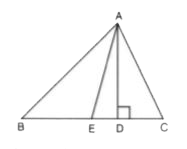In triangle ABC, D is mid-point of AB and CD is perpendiicular to AB. Bisector of ∠ABC meets CD at E and AC at F. Prove that:
E is equidistant from A and B
To prove that point E is equidistant from points A and B in triangle ABC, where D is the midpoint of AB, CD is perpendicular to AB, and the angle bisector of angle ABC meets CD at E and AC at F, we can follow these steps:
1. Identify the Triangle and Points:
- Let triangle ABC be given with D as the midpoint of AB.
- Draw CD perpendicular to AB.
- Let the angle bisector of angle ABC intersect CD at point E and AC at point F.
2. Triangles to Consider:
- We will consider triangles AED and BED.
3. Common Side:
- Note that ED is a common side in both triangles AED and BED. Thus, we can write:
ED=ED(common side)
4. Right Angles:
- Since CD is perpendicular to AB, we have:
∠EDA=90∘and∠EDB=90∘
- Therefore, we can say:
∠EDA=∠EDB
5. Midpoint Property:
- Since D is the midpoint of AB, we have:
AD=BD
6. Applying the Congruence Criteria:
- Now we have two triangles AED and BED with:
- ED = ED (common side)
- ∠EDA=∠EDB=90∘
- AD = BD (since D is the midpoint)
- By the Side-Angle-Side (SAS) congruence criterion, we can conclude:
△AED≅△BED
7. Conclusion from Congruence:
- Since the triangles AED and BED are congruent, we can state:
EA=EB
- This means that point E is equidistant from points A and B.
8. Final Statement:
- Therefore, we conclude that:
E is equidistant from A and B.
- Let triangle ABC be given with D as the midpoint of AB.
- Draw CD perpendicular to AB.
- Let the angle bisector of angle ABC intersect CD at point E and AC at point F.
- We will consider triangles AED and BED.
- Note that ED is a common side in both triangles AED and BED. Thus, we can write:
ED=ED(common side)
- Since CD is perpendicular to AB, we have:
∠EDA=90∘and∠EDB=90∘
- Therefore, we can say:
∠EDA=∠EDB
- Since D is the midpoint of AB, we have:
AD=BD
- Now we have two triangles AED and BED with:
- ED = ED (common side)
- ∠EDA=∠EDB=90∘
- AD = BD (since D is the midpoint)
- By the Side-Angle-Side (SAS) congruence criterion, we can conclude:
△AED≅△BED
- Since the triangles AED and BED are congruent, we can state:
EA=EB
- This means that point E is equidistant from points A and B.
- Therefore, we conclude that:
E is equidistant from A and B.
Topper's Solved these Questions
- CHAPTERWISE REVISION EXERCISEBOOK - ICSECHAPTER - CHAPTERWISE REVISION EXERCISEEXERCISE - CHAPTERWISE REVISION EXERCISE (CIRCLES)
9 Videos
- CHAPTERWISE REVISION EXERCISEBOOK - ICSECHAPTER - CHAPTERWISE REVISION EXERCISEEXERCISE - CHAPTERWISE REVISION EXERCISE (TANGENTS AND INTERSECTING CHORDS)
10 Videos
- CHAPTERWISE REVISION EXERCISEBOOK - ICSECHAPTER - CHAPTERWISE REVISION EXERCISEEXERCISE - CHAPTERWISE REVISION EXERCISE (SIMILARITY)
10 Videos
- BANKING (RECURRING DEPOSIT ACCOUNTS)BOOK - ICSECHAPTER - BANKING (RECURRING DEPOSIT ACCOUNTS)EXERCISE - QUESTIONS
7 Videos
- CIRCLESBOOK - ICSECHAPTER - CIRCLESEXERCISE - EXERCISE 17( C )
28 Videos
Similar Questions
In triangle ABC, D is mid-point of AB and CD is perpendiicular to AB. Bisector of ∠ABC meets CD at E and AC at F. Prove that:
F is equidistant from AB and BC.
View SolutionThe given figure shows a triangle ABC in which AD bisects angle BAC. EG is perpendicular bisector of side AB which intersects AD at point F.
Prove that : F is equidistant from AB and AC.
View SolutionConstruct a triangle ABC, in which AB = 4.2 cm, BC = 6.3 cm and AC = 5 cm. Draw perpendicular bisector of BC which meets AC at point D. Prove that D is equidistant from B and C.
View SolutionIn triangle ABC, AB > AC. E is the mid-point of BC and AD is perpendicular to BC. Prove that : AB2+AC2=2AE2+2BE2

View SolutionIn the figure, BX bisects angle ABC and intersects AC at point D. Line segment CY is perpendicular to AB and intersects BX at point P. If Y is mid-point of AB, prove that : point P is equidistant from A and B.
View SolutionIn triangle ABC, AB=AC and BD is perpendicular to AC. Prove that : BD2−CD2=2CD×AD
View SolutionIn a triangle ABC, D is a point on BC such that AD is the internal bisector of ∠A. Let ∠B=2∠C and CD = AB. Then ∠A is
View SolutionABC is a right triangle with AB = AC.If bisector of ∠A meet BC at D then prove that BC =2 AD .
View SolutionIn a triangle ABC,D is the mid - point of BC, AD is produced upto E so that DE = AD.
Prove that :
AB=EC
View SolutionIn a triangle ABC, AD is a medium and E is mid-point of median AD. A line through B and E meets AC at point F.
View Solution
